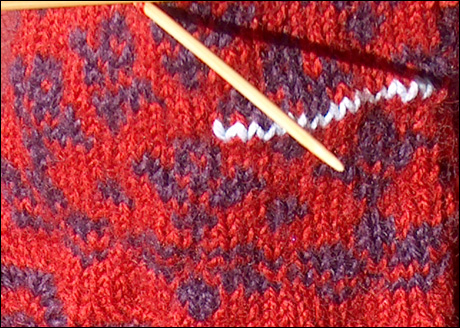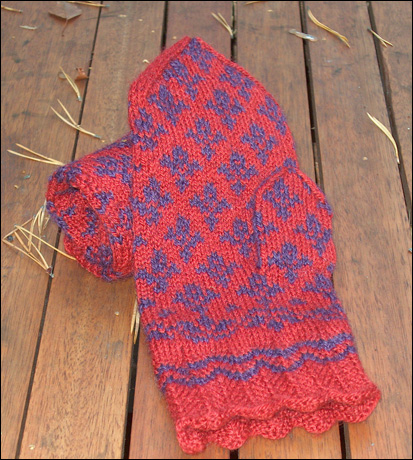It's hardly a surprise for those who know my knitting habits even a little bit that I love knitting Estonian mittens and socks. I don't know why, but there is something in the small scaled patterns, the rhythm of the patterns that speaks intensely to me. I like Estonian mittens more than Latvian mittens, and way more than the Norwegian mittens I used to knit before I first opened Nancy Bush's book Estonian folk knitting. It felt like coming home, the mittens did have everything I liked in Norwegian mittens, and nothing of the things I didn't. And I think I can't blame my ancestors for this, the genetic heritage of those who lived in Estonia 250 years ago must be pretty diluted today.
I think I found one reason why I feel so at home with the Estonian mittens, and it has to do with my earlier weaving activities. Before my babies started to grow into schoolchildren in need of rooms of their own I had a craft room, where I kept the family loom I have. It has been in my husbands family for about 150 years, a quite big sturdy thing (that sad to say is now stored away in pieces, waiting for the kids to move out). I was very interested in how old fabrics were woven, and I studied lot of books on old-fashioned clothing. Perhaps my unconscious mind did take up pictures of mittens resembling the Estonian mittens I later would take to my heart.
 I decided that the mittens my family will receive this year will all have patterns that originate from Finland. There are so many different styles, and I think they have been very poorly exhibited and showed. Mittens from Kymenlaakso are partly very similar to the Estonian mittens. They share many pattern, some pattern have even the same name as the Estonian name. The cuffs are often simpler, and the most intricate pattern that the Estonian mittens represent are not present among the Kymenlaakso mittens. Mittens from the south of Pohjanmaa have elements that remind of old pheasant painted furniture, and are quite different from the Kymenlaakso mittens, but do also have similar features. And mittens from the Swedish speaking areas of Pohjanmaa have again their own twist, totally different from the south of Pohjanmaa. In Lapland are mittens again different, the Rovaniemi mitten is somewhat known but other styles not so. And then we have the thrum mittens. Not as thick as the thrum mittens in Canada, but still warm and with very interesting cuffs.
I decided that the mittens my family will receive this year will all have patterns that originate from Finland. There are so many different styles, and I think they have been very poorly exhibited and showed. Mittens from Kymenlaakso are partly very similar to the Estonian mittens. They share many pattern, some pattern have even the same name as the Estonian name. The cuffs are often simpler, and the most intricate pattern that the Estonian mittens represent are not present among the Kymenlaakso mittens. Mittens from the south of Pohjanmaa have elements that remind of old pheasant painted furniture, and are quite different from the Kymenlaakso mittens, but do also have similar features. And mittens from the Swedish speaking areas of Pohjanmaa have again their own twist, totally different from the south of Pohjanmaa. In Lapland are mittens again different, the Rovaniemi mitten is somewhat known but other styles not so. And then we have the thrum mittens. Not as thick as the thrum mittens in Canada, but still warm and with very interesting cuffs.
I have started some initial research, reading books and taking a tour at the archives of the National Museum. I have looked at pictures in the archive, read notes about the mittens, and read through Anna Rauhala's excellent pro gradu exam work on mittens from Kymenlaakso and the outer islands. I have not had a chance to examine any mittens personally, and there are a lot of models I haven't got verified. But I have started :-)

The first pair of mittens will be for my older daughter. The yarn is Vuorelma's Satakieli, in a red that looks like it had been dyed with madder, and a purple that look like it has been dyed with madder and indigo. I have decided not to stick to the original colours, since they were very often sheep white and sheep black, but to try to find colours that could have been created before the synthetic colours took over. The yarn will of course not be dyed with natural dyes, I haven't the time to start involving me in that again, but the colour shade have to look natural. The pattern for these mittens is found in Eeva Haavisto's book Sataa kansanomaista kuviokudinmallia, and it is from Jalasjärvi in south Pohjanmaa. I have not got this specific pattern verified with a museum item, but about half of all the models in Haavisto's are mittens I have found pictures of, and her only changes seams to be that she perhaps has adapted some mittens to a slightly thicker yarn than the original. Thus I assume it to be quite original. According to Rauhala’s research in Kymenlaakso mittens did most old mittens have a stitch count of 40-50 stitches to 10 cm. Haavisto's models have less than this, perhaps as a result of the commercial yarns that started to be more available in the 1940's, when her book was published.
The cuff of the mitten is actually not a mitten cuff. I took the model from a picture of an old sock from Pohjanmaa, but I think it works pretty nice as cuff too. The pattern was called zig-zag pattern. More on the knitting details of the mitten when I advance.
The pattern of the hand does not have a name, so I have decided to call the mittens the Jalasjärvi flower mittens.






